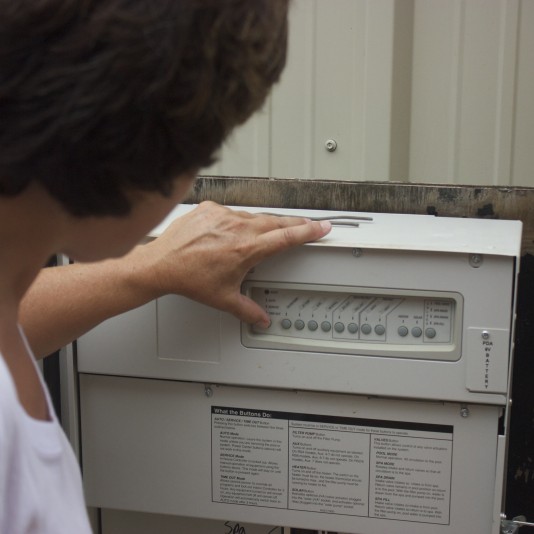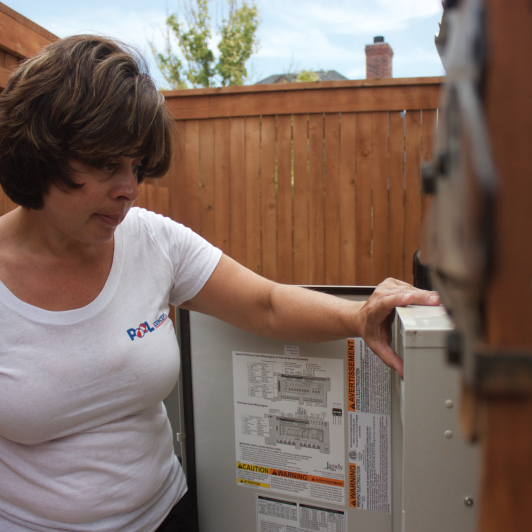FILTER REPAIR

Filter Maintenance
Proper pool maintenance is a must to keep your pool water sparkling and clean. One of the most important pieces of equipment to maintain is the filter. There are three basic types of filtration systems – Sand, Cartridge and DE. Whichever system you have, you will need to be sure to clean and care for your filter.
Sand Filters
A sand filter tank is made of metal or fiberglass and contains a thick bed of special-grade sand. While filtering, dirty water from the pool comes in through the filter’s inlet pipe, which leads to the water distribution head inside the tank. While gravity pulls the water down through the sand, tiny sand particles catch dirt and debris. At the bottom of the tank, the filtered water flows through the pick-up unit and out the outlet pipe. If the water flow is slowed by dirt and debris, pressure gauges at the filter inlet and outlet give the pool owner an idea of the blockage level inside. If the inlet pipe has more pressure than the outlet pipe, there is collected debris in the sand. You will then need to backwash the filter. The coarseness of sand traps debris particles and over time, the sand will become smooth and round. This sand should be changed every five years. This filter is designed to clean your pool water up to 30 to 40 Microns.
Diatomaceous Earth Filters
The DE pool filter differs from other types because of the filter media itself. In this case, the DE is the filter media. DE is an extremely fine powder that is produced by crushing the fossilized exoskeletons of diatoms. These ancient hard-shelled organisms were similar to algae, but the porous bone material makes an excellent filter when used in this way. The powdered skeletons coat a fabric-covered filter grid that keeps the DE itself from washing back into the pool. Adding new DE is simple. It goes directly into the skimmer and the pump sucks the DE into place preparing it to do its job as more contaminants enter the water. Back washing and addition of new DE is required once or twice a year for residential pools. This filter is very eco-friendly and is designed to clean your pool water up to 5 microns.
Cartridge Filters
Swimming pool filter cartridges work by allowing water to pass through a very fine filter surface. This filter surface captures any impurities that attempt to pass through and hold them until you clean the filter cartridge or replace it. Cartridge filters have more surface area than sand filters. Cartridge filters also operate at a much lower pressure than sand. This causes less back pressure on the pump so you have a greater flow of water through the system. The best way to ensure a clean and sparkling pool is to just simply replace them, which should be done every 3-5 years. This filter provides the absolute cleanest water for your swimming pool.
FILTER QUESTIONS
My pool pump is very noisy, is it time to replace it?
There are several reasons a pump can be noisy and each poses a different repair aspect. When air is introduced into a pump it is called cavitation. Sometimes air is introduced because of a poor hydraulic design in the plumbing. Most of the time, air is introduced due to a leak in the pipes that lead into the suction side of the pump. All pumps have two ‘ball bearing’ assemblies, one at the front of the motor and one at the back. The most common bearing failure is due to a leaking seal which allows water to enter the motor through the front bearing. Bearing failures usually start as a ‘whine’ and quickly develop into a loud grinding noise, or an all out ‘screaming’ sound. As a motor repair or replacement is fairly technical, we recommend you call us for a service appointment to determine and fix the source of the noise.


What is the normal water pressure for my filter?
Each swimming pool system has different water pressure tolerances. Please refer to your original owner’s equipment manual and/or startup instructions to identify the range of proper pressure for your swimming pool.
• If you suspect that the pressure is too high, confirm that the pressure gauge reads zero when the equipment is off. If it does not fall back down to zero, you will need to replace the gauge.
• If you suspect that the pressure is too low, check and clean out all debris from baskets. In addition, check to see if all your equipment valves are set properly.
• If you suspect that the pressure is too low, check to see if the gauge reads zero when the equipment is off. If it does not fall back down to zero, you will need to replace the gauge.
Pools in the Southwest can lose up to one half inch of water a day to evaporation. There are several inspections you can make if you think your water loss is excessive: Please note that electrical repairs can be hazardous or fatal if done improperly – always refer electrical repairs to a professional. Each swimming pool system has different water pressure tolerances.
